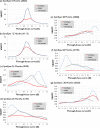Ray tracing optimization: a new method for intraocular lens power calculation in regular and irregular corneas
- PMID: 36941337
- PMCID: PMC10027892
- DOI: 10.1038/s41598-023-31525-8
Ray tracing optimization: a new method for intraocular lens power calculation in regular and irregular corneas
Abstract
To develop a novel algorithm based on ray tracing, simulated visual performance and through-focus optimization for an accurate intraocular lens (IOL) power calculation. Custom-developed algorithms for ray tracing optimization (RTO) were used to combine the natural corneal higher-order aberrations (HOAs) with multiple sphero-cylindrical corrections in 210 higher order statistical eye models for developing keratoconus. The magnitude of defocus and astigmatism producing the maximum Visual Strehl was considered as the optimal sphero-cylindrical target for IOL power calculation. Corneal astigmatism and the RMS HOAs ranged from - 0.64 ± 0.35D and 0.10 ± 0.04 μm (0-months) to - 3.15 ± 1.38D and 0.82 ± 0.47 μm (120-months). Defocus and astigmatism target was close to neutral for eyes with low amount of HOAs (0 and 12-months), where 91.66% of eyes agreed within ± 0.50D in IOL power calculation (RTO vs. SRK/T). However, corneas with higher amounts of HOAs presented greater visual improvement with an optimized target. In these eyes (24- to 120-months), only 18.05% of eyes agreed within ± 0.50D (RTO vs. SRK/T). The power difference exceeded 3D in 42.2% while the cylinder required adjustments larger than 3D in 18.4% of the cases. Certain amounts of lower and HOAs may interact favourably to improve visual performance, shifting therefore the refractive target for IOL power calculation.
© 2023. The Author(s).
Conflict of interest statement
The authors declare no competing interests.
Figures







Similar articles
-
Predictability of Refractive Outcome of a Small-Aperture Intraocular Lens in Eyes With Irregular Corneal Astigmatism.J Refract Surg. 2021 May;37(5):312-317. doi: 10.3928/1081597X-20210222-03. Epub 2021 May 1. J Refract Surg. 2021. PMID: 34044696
-
Changes in astigmatism and corneal higher-order aberrations after phacoemulsification with toric intraocular lens implantation for mild keratoconus with cataract.Jpn J Ophthalmol. 2016 Jul;60(4):302-8. doi: 10.1007/s10384-016-0449-x. Epub 2016 May 10. Jpn J Ophthalmol. 2016. PMID: 27165708
-
Toric intraocular lens power calculation in cataract patients with keratoconus.J Cataract Refract Surg. 2021 Nov 1;47(11):1389-1397. doi: 10.1097/j.jcrs.0000000000000638. J Cataract Refract Surg. 2021. PMID: 33770295
-
Toric intraocular lenses: Evidence-based use.Clin Exp Ophthalmol. 2022 Jul;50(5):481-489. doi: 10.1111/ceo.14106. Epub 2022 May 29. Clin Exp Ophthalmol. 2022. PMID: 35584257 Free PMC article. Review.
-
Corneal Topography for Intraocular Lens Selection in Refractive Cataract Surgery.Ophthalmology. 2021 Nov;128(11):e142-e152. doi: 10.1016/j.ophtha.2020.11.016. Epub 2020 Nov 19. Ophthalmology. 2021. PMID: 33221325 Review.
Cited by
-
A Multi Comparison of 8 Different Intraocular Lens Biometry Formulae, Including a Machine Learning Thin Lens Formula (MM) and an Inbuilt Anterior Segment Optical Coherence Tomography Ray Tracing Formula.Vision (Basel). 2024 Aug 28;8(3):49. doi: 10.3390/vision8030049. Vision (Basel). 2024. PMID: 39311317 Free PMC article.
-
Impact of Cataract Surgery on Higher Order Aberrations and Comparative Analysis using Scheimpflug imaging and ray-tracing technology.Rom J Ophthalmol. 2025 Jan-Mar;69(1):60-67. doi: 10.22336/rjo.2025.11. Rom J Ophthalmol. 2025. PMID: 40330965 Free PMC article.
References
Publication types
MeSH terms
LinkOut - more resources
Full Text Sources
Other Literature Sources
Research Materials

